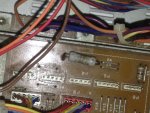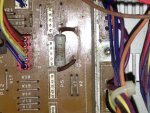Hi all,
Sweetbeatz has been helping me the last few weeks with getting my 388 back in order, but he's advised me to start a new thread with a new problem that it's developed.
I've had problems with the motor engaging. Reflowed all the joints around power, servo and mother boards, which sorted the motor no starting problem, but I've now noticed a resistor on the motherboard that is getting insanely hot. I smelt burning before I reflowed the solder but figured it was to do with the motor issue, but it's this resistor. I've put a picture of the one in question below, it's on the right side of the mother board, right next to the transformer.
It's also developed a problem of rewind and fast forward being real slow. The motor problem I had was intermittent, so when it was working the ff and rr worked fine, it's only since I've put it back down flat that theres been an issue. I've tried adjusting the servos but no joy. It's like they start normally when I press rewind, but the rollers lift up like they do when you use return to zero, to slow the tape before it stops. It still plays, records etc fine.
Any help would be massively appreciated! Sure it's something stupid I've done when I was fixing it, but your own stupid's hard to spot.

Sweetbeatz has been helping me the last few weeks with getting my 388 back in order, but he's advised me to start a new thread with a new problem that it's developed.
I've had problems with the motor engaging. Reflowed all the joints around power, servo and mother boards, which sorted the motor no starting problem, but I've now noticed a resistor on the motherboard that is getting insanely hot. I smelt burning before I reflowed the solder but figured it was to do with the motor issue, but it's this resistor. I've put a picture of the one in question below, it's on the right side of the mother board, right next to the transformer.
It's also developed a problem of rewind and fast forward being real slow. The motor problem I had was intermittent, so when it was working the ff and rr worked fine, it's only since I've put it back down flat that theres been an issue. I've tried adjusting the servos but no joy. It's like they start normally when I press rewind, but the rollers lift up like they do when you use return to zero, to slow the tape before it stops. It still plays, records etc fine.
Any help would be massively appreciated! Sure it's something stupid I've done when I was fixing it, but your own stupid's hard to spot.

Last edited:


 Guess that could be because I've been messing with the servos though.
Guess that could be because I've been messing with the servos though.


